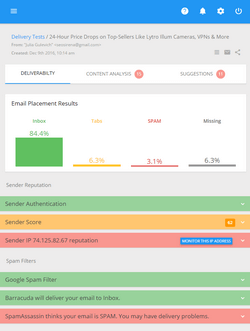How HTML Code Affects Anti-Spam Filters
It is believed that an email gets filtered because it contains any of spam trigger words or phrases or because the sender is unknown to the recipient. This is not always true. Of course, certain words and phrases may cause a message being filtered but ISPs may also block your legitimate email for reasons you may not be thinking of, for example a HTML code.
You know some ISPs rely on the message HTML code to determine whether the email is legitimate or spam. For instance, the emails with an outdated or incorrect code end up in bulk or junk mail folders when sent to such domains as MSN/Hotmail and AOL. Why do some ISPs validate HTML code? Because of spammers, of course. Using wrong HTML syntax spammers try to fool standard content filters.
You may think that everything is OK with your HTML code if the message renders correctly and looks just fine to you. Not always! Each ISP handles email differently, and the messages that get past the filters at one destination may be filtered or entirely blocked at another.
Here are some particularities of a HTML code that can trigger anti-spam filters:
- A tracking beacon below the closing HTML tag will lead the message being filtered to the bulk folder at MSN/Hotmail.
- An indistinct border between the text and HTML parts of a multipart email message sends the email to the bulk folder at MSN/Hotmail.
- Hex-encoded domains in URLs (for example, substituting the code “%20” for a space in a URL) can get your email blocked or sent to the bulk folder at AOL, CompuServe, and MSN/Hotmail.
- A disguised link that shows one URL in the email but actually redirects the recipient to another URL also sends the email to the bulk folder at MSN/Hotmail. This technique is commonly used by phishers, scammers who write on behalf of financial institutions to steal Social Security, bank, or credit account numbers.
- Some common errors, such as the “<a/>” to close a HTML tag instead of the “</a>” can trigger the AOL anti-spam filter that will reject the email message.
With all that said, take some time to check the HTML code of you email carefully and correct any syntax errors before sending the email to the list.
Posted by Julia Gulevich
Table of contents | Page list for this chapter | Next page

Buy your own copy of Ultimate Email Marketing Guide
You’ve browsed the site and read some chapters, now get your own copy of the book in PDF.
$19 in PDF Instant download
All content copyright ©2008 G-Lock Software, Ltd. All rights reserved. No part of this book or site may be reproduced or redistributed in any form or by any electronic or mechanical means, including information storage and retrieval systems, without permission in writing from G-Lock Software, except by a reviewer who may quote brief passages in a review.

